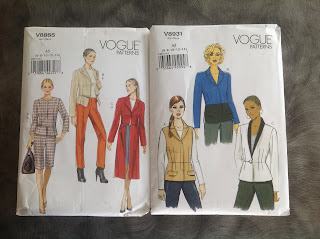 |
| Seam ripper. Friend or enemy? Frienemy? |
Alas, that's what spewed from mine yesterday when I inspected the single welt pocket on the upper left front of Studmuffin's jacket, aka the breast pocket or the hankie pocket. Instead of a smooth insertion, I had a lumpy, bumpy mess.
One of my primary goals when sewing is to make things that look nice. Not perfect, mind you, just nice. If it looks nice, I am happy. (And not the-man-on-horseback-glancing-your-way-as-he-gallops-by kind of nice. More the it-passes-casual-observation level of nice.) This was not nice. The fabric around the pocket was puckery and stressed.
I hate how welt pockets are made. The "sew two parallel lines, then cut a Y shaped hole between them and flip everything to the inside" technique makes me uncomfortable. The whole thing rests on the fabric not fraying, as there isn't any stitching on the ends to hold threads in check. There are alternate construction methods for double welts, but I haven't found any for the single welt.
An aside: Another sewing philosophy/attitude I have is: Think For Yourself. That's a rather harsh sentiment for many people, so I try to pretty it up by saying: You Are The Boss of Your Own Sewing. But they are two sides of the same coin. Just because the pattern instruction/tradition/your fav sewing guru tells you to do a something a certain way doesn't mean you have to - or should.
Think about what you're creating. Does the suggested way make sense? The tingle of uncertainty or unease is your subconscious' way of telling you Uh-uh! No thanks! Danger Will Robinson! (The last one is from Lost in Space, a tv show I watched with annoying regularity as a child. It's amazing what sticks in your brain.)
I ignored my tingle. I know better. I know better. But I did, because who am I to poo-poo the traditional methods of tailoring.
I'm Lady T, of course. The Boss of My Own Sewing. Once I thought about it, two alternative ways of constructing this thing popped into my mind. Two, not just one.
Today, I have to pick out that woeful pocket. I'm hoping I can rework it, making the opening a teensy bit bigger. Otherwise I'm going to have to recut the front, fuse it, thread trace it, blah, blah, blah all over again. I'm very lucky I have enough fabric left over (barely!) to have this option.
Who is the boss of your sewing? You? Or tradition?
Till next time,
Lady T


















